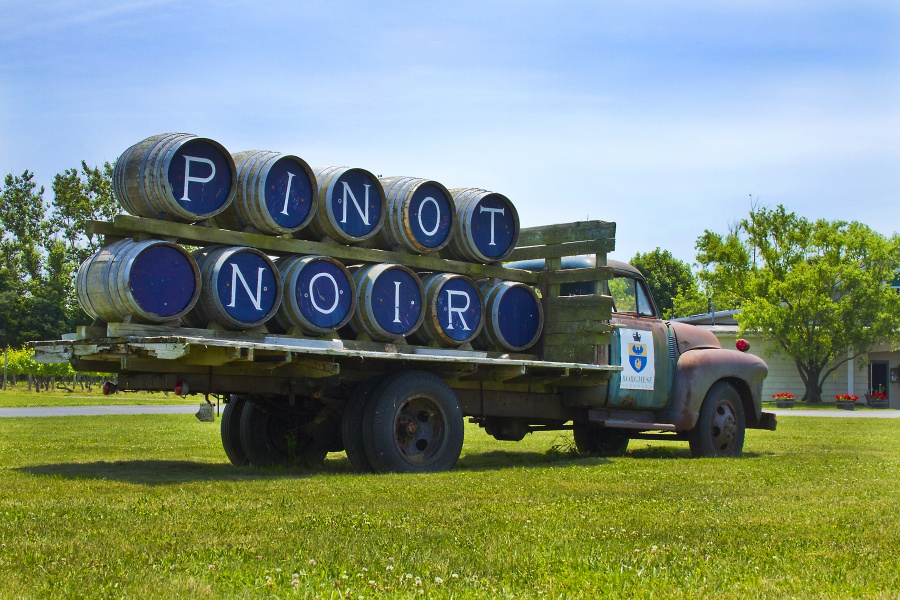LI’s First Vineyard, Castello di Borghese

Over the last few years, the North Fork Wine Trail has grown to include more than 50 vineyards, wineries and tasting rooms. But which one was first?
As it turns out, it’s Castello di Borghese Vineyard and Winery in Cutchogue, whose first vines were planted in 1973. The vineyard was originally owned by Louisa and Alex Hargrave, who ran it until 1999 when they sold it to Marco and Anne Marie Borghese. Castello di Borghese is an 80-acre farm, 40 of which are devoted to growing grapes, where the Borghese’s currently live.
The vineyard is easy to spot on Route 48—you can’t miss the ramshackle flatbed truck stacked with old wine barrels spelling out “Pinot Noir.” The pinot grape is notoriously difficult to grow on Long Island, but Castello di Borghese seems to do it with ease. They work so well with it, in fact, that they use it in four different wines, including a white pinot, which happened to be the first wine I tasted on my visit.
The 2012 Bianco di Pino Noir is a fruit-forward white made from skinned pinot noir grapes, fermented in stainless-steel barrels. This white has the consistency of a chardonnay with a peach-like flavor. It’s not overpoweringly sweet, but it tastes great—last year’s first run sold out in two months.
The second wine I tasted was the 2012 Estate Riesling. This wine has a unique sour-apple flavor. It’s not overly sweet, but the residual sugar on the end leaves you with a flavor of apricot and sweet pear.
Next on my flight was the 2012 Estate Chardonnay. This steel-fermented white has a medium body that is crisp and refreshing. It has a bright flavor with apple and citrus notes and a hint of vanilla.
The last white I tasted was the 2012 Sauvignon Blanc. This oaked white has a lot of citrus notes along with a bit of lemon zest. It’s a very light and refreshing white wine with a dry, clean flavor that is perfect of a hot summer day.
I made my way on to Castello di Borghese’s reds, and began with the 2008 Estate Reserve Pino Noir. The two other wines Castello di Borghese makes with their prized pinot noir grapes are a barrel-fermented pinot noir and a rosé.
The 2008 Estate Reserve Pino Noir is done in the French Bordeaux style and is aged in vintage French oak barrels. This red has a lot black cherry notes and a spicy finish with a burst of cinnamon and tea.
The next red I tried was the 2007 Merlot, which I was pleasantly surprised with. This merlot has cherry and plum flavors, and it is semi-dry, so it’s not overwhelming on the palate. The wine is also fairly light for a merlot, so it has a great drinkability.
Following the merlot, it was on to the cabernets. The first I tried was the 2010 Cabernet-Franc. The cabernet-franc grape has done very well on Long Island. This deep red wine is layered with toasted oak, dark berry and vanilla notes on the nose, and has an earthy, almost herbal, spiciness that compliments its tart cherry and plum flavors.
The second Cabernet on my list was the 2010 Cabernet Sauvignon Reserve. This bold red is nearly purple in color and blossoms with cherry, chocolate and currant flavors. This wine will age dramatically.
Castello di Borghese’s crown jewel, their 2007 Meritage, is a blend of these three reds. The merlot, cabernet franc and cabernet sauvignon are perfectly balanced, creating layers of spice, dark and red berries and plum that come together for a delicate but complex finish.
After every great tasting comes dessert, and mine was Allegra—the ice wine. This sweet wine, named for the Borghese’s daughter, is made from late-harvest chardonnay grapes that are handpicked at their peak sugar content and then flash-frozen. Allegra is thick, and sweet, with apricot fragrance and flavor.
Visit Castello di Borghese at 17150 County Road 48, Cutchogue. 631-734-5111, castellodiborghese.com



